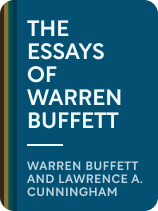

This article is an excerpt from the Shortform book guide to "The Essays of Warren Buffett" by Warren Buffett and Lawrence A. Cunningham. Shortform has the world's best summaries and analyses of books you should be reading.
Like this article? Sign up for a free trial here.
What is the book The Essays of Warren Buffett about? What is the key message to take away from the book?
Compiled from Buffett’s annual reports to Berkshire Hathaway shareholders, The Essays of Warren Buffett provides a glimpse into the mind of a man whose ideas contrast with those of the typical Wall Street mogul. His insights on investing are simple yet difficult to put into practice, while his thoughts on the culture of the wider business world shine a light on the values that shape modern finance.
Below is a brief overview of The Essays of Warren Buffett: Lessons for Investors and Managers.
The Essays of Warren Buffett: Book Overview
In 2008, Warren Buffett was declared the richest person in the world. As the CEO of Berkshire Hathaway, he commands a business empire that includes insurance companies, media companies, manufacturing, clothing, and even makers of candy and sodas. Yet Buffett has as much a reputation as a teacher as he does as a business tycoon.
The Essays of Warren Buffett: Lessons for Investors and Managers provides a window into the mind of the world’s most successful investor, a man whose ideas and values are in stark contrast with the stereotypical Wall Street business mogul.
In this guide, we’ll cover Buffett’s writings on investment practices in general and what goes on behind the scenes in the world of high finance. On investing, we’ll examine Buffett’s recommended practices, which ideas he considers to be faulty in the realm of economics, and specific types of investments to avoid. In the investment business section, we’ll contrast his views on the typical Wall Street firm with the culture and principles of Berkshire Hathaway.
In addition to illustrating Buffett’s ideas, we’ll look at the writings of other financial experts, both those in agreement with Buffett’s way of thinking and those who present an alternate view. We’ll place Buffett’s career and essays in their appropriate historical context, and we’ll look at how well his ideas hold up in the modern world of investment.
How to Invest
For casual and professional investors alike, the most salient insights from Buffett’s essays are his thoughts about the dos and don’ts of the stock market. The key philosophy that Buffett drives home is that owning a stock means owning a piece of an actual, real-world business. Using this “owner mindset” as a starting point, Buffett provides guidance to reasonable expectations, best practices in investing, common economic modes of thought that Buffett believes are utter nonsense, and certain pitfalls to avoid when investing.
In summary, Buffett recommends you identify and invest in a solid, well-run business at a time when that business’s stock is offered at a discount to its overall value. Buffett’s strategy is conceptually simple, though it entails a lot of work for investors to learn how to properly value businesses in order to know if the price is high or low. Once you buy into a good business, Buffett recommends holding on to its stock indefinitely so long as the business remains well-managed and provides a steady return on capital. Because the value of a stock is directly linked to the fortunes of the business itself, in the long run, stocks can’t provide higher returns on investment than the businesses they represent can turn capital into profit.
This goes against Wall Street’s common narrative, in which stock prices and businesses’ value have little to do with each other. In general, the market trends upward over time, but Buffett is clear that the market is driven by investors’ collective emotional mood swings. Those swings sometimes offer great buys at good prices, but otherwise you should ignore the random moods of the market. Some short-term traders may use swings in the market to make a quick buck, but most of them will fail. Meanwhile, trading itself causes a financial drain in the form of fees to investment banks and brokers. Buffett endorses long-term financial commitments in which you can make the most of your dollar.
Best Practices
Though Buffett’s essays mainly explain how he makes investment decisions on behalf of Berkshire Hathaway shareholders, he shares a great deal of advice that applies to individual investors as well. Principal among these are that you should invest in industries you understand, recognize the value of market volatility, and put your money in simple index funds to benefit from the market’s general upward momentum.
Buffett drives home the business ownership aspect of buying stock and suggests that you use any industry knowledge you have to your advantage. For example, if your work overlaps with the publishing industry, then you know which companies are the industry leaders and which have the best future prospects. If the top two or three are publicly traded and their stock doesn’t seem overpriced, put a significant amount of money into those businesses.
You are now an owner of a piece of a business that you understand well. If the company’s stock shoots up after you buy it, don’t consider that a signal to sell. Rather, look forward to your long-term gains as an owner rather than the short-term gains you may receive from trading.
Buffett says that in the short run, stock prices aren’t a good measure of a business’s true value. Instead, what matters is whether a company makes effective use of capital to produce good returns in the form of steady profits. For this reason, avoid industries in which you lack knowledge and where future prospects are hard to predict. Buffett favors companies whose products can weather any market downturn—items that people will always need to buy regardless of economic ups and downs, such as food, clothing, insurance, and utilities.
The Upside of Volatility
While downturns and volatility can be frightening, Buffett echoes his teacher Benjamin Graham who said that for investors, volatility is good. Because the market’s behavior is irrational, it occasionally offers fantastic deals. And while rising stock prices may be pleasing to owners, if you’re an investor buying into a company, you want stock prices to be low. High stock prices are only beneficial to people intending to sell. As long as a company’s stock price remains low, you can get higher returns on your money by buying ever-larger portions of the business.
If you don’t have the time or resources to do thorough research into business valuation, he recommends putting your money into a simple, unmanaged S&P index fund. That way your gains will match the overall market with minimal loss to brokerage trading fees. Forget the excitement that comes from day trading and watching individual stocks go up and down. Remember that every trade loses money to fees, and that trying to “beat the market” in your gains is tantamount to gambling at a casino.
Economic Nonsense
While much of Buffett’s writing seems like common sense, his ideas go against the grain of many financial professionals’. Buffett himself points out where his views and those of other investors disagree. Three specific points of contention are Efficient Market Theory, diversified portfolios, and the supposed value of financial advisers.
Efficient Market Theory
Efficient Market Theory (EMT) is based on the premise that financial markets are inherently rational and all-knowing. Proponents of EMT believe that stock prices always reflect the actual value of their companies, making any deeper analysis irrelevant—stock price fluctuations are sufficient to determine a company’s overall health. Buffett disagrees strongly, and he points to his history and those of his associates who have made their fortunes by assuming instead that researching a company reveals its true worth, and that stock fluctuations are largely meaningless except for the opportunities they provide. He feels that EMT has been sufficiently discredited so he finds it annoying that it’s still taught in business schools.
Diversification
Another financial sacred cow that Buffett scorns is the idea that diversifying your portfolio protects against risk. He argues that this concept originates from academic models that equate risk with volatility and use diversification as a means to minimize the total volatility in your investments. As in EMT, this theory takes nothing into account except stock price—if a good company’s stock were to suddenly drop, this mode of thinking would label it risky and tell you not to buy it. Buffett defines risk as the odds of suffering financial harm and says the best way to avoid it is to put most of your money on a few safe bets—companies with good management and excellent long-term economics, no matter their short-term stock fluctuations.
A glance at Berkshire Hathaway’s diversified holdings may make it look like Buffett doesn’t take his own advice. However, several factors must be noted. 1) As a holding company, Berkshire has far too much money to invest in only one place. 2) Most of its investments are in the form of majority shares in the businesses it owns—when Berkshire buys into a company, it commits a significant amount of capital instead of merely buying a few stocks as a hedge against market volatility. 3) Though Berkshire’s investments are widely diversified, Buffett’s personal holdings are not. Nearly all of Buffett’s wealth is in the form of Berkshire Hathaway stock.
Financial Advisers
Most of all, Buffett derides the culture of brokers and advisers who create and sell complicated financial instruments, encourage people to make trades often, and obfuscate any market clarity to convince investors that their services are needed. It’s said that the person who gets richest from a gold rush is the one selling the shovels. Likewise, the chief result of the efforts of brokers, advisers, and money managers is the transfer of wealth away from investors into the hands of “investment professionals,” skimmed off the top in the form of service fees. And while financial advisers and money managers claim they’ll be able to outperform the overall market, the vast majority of them will fail.
These professionals feed off both fear and optimism in the market in order to enrich themselves. The system incentivizes brokers and advisers to recommend more trades and more financial products even in times when investors would be wiser to let their money sit in an index fund with minimal fees. What’s worse, advisers bear none of the risk as their clients’ fortunes rise or fall.
What to Avoid
From his discussion of his choices, Buffett clearly prefers equities (stocks and bonds) over other forms of investment. Nevertheless, he spends time explaining several other forms of investment and the reasons that they’re problematic. He discusses unproductive assets, junk bonds, financial derivatives, and the worst sin of all, using debt to finance acquisitions.
Some bad investments are made out of fear—people want to keep their money safe in case of a financial crisis. Money market funds and bonds appear safe, but Buffett points out that their interest doesn’t keep pace with inflation. Money in those investments loses value, even as the total dollar figure slowly rises.
More foolish, though, is to invest in assets that are completely unproductive, such as jewelry, collectibles, or gold. Unlike a business, these investments create nothing. These items only have value at all as long as people believe that they do. People who invest in unproductive assets hope that someone else will pay a higher price for them in the future, a hope based more in fantasy than fact.
Fantasy also drives the market for junk bonds. These are bonds issued by companies that are already saddled with more debt than they can bear. Junk bonds are a way to refinance that debt, but the issuing companies are in such poor financial straits that they still pose a very high risk of default. Nevertheless, there are investment firms that funnel lots of money into the junk bond market, believing once again that diversification minimizes risk. In the case of junk bonds, this is much the same as buying a lot of lottery tickets in order to increase your chance of winning. Buffett writes that junk bonds exacerbate financial crises on a regular basis.
Financial Derivatives
The most troublesome of all complex financial products are derivatives, such as those that drove the subprime mortgage crisis. Buffett explains that derivatives are contracts between two parties in which one pays the other if some other financial instrument (for example, a stock or a bond) reaches a certain price, up or down. In the simplest terms, derivatives are bets that a portion of the market will behave a certain way. They are instruments of pure speculation, and unless there’s some form of collateral involved, a derivative’s value rests entirely on the financial strength of the parties involved in the gamble.
Buffett argues that derivatives are also instruments of fraud. Until the derivative actually comes due, both parties to the bet can use fictitious projections to claim that their derivatives produce actual earnings, and then get paid by their investors based on those supposed earnings (like receiving a cut from a race horse’s winnings before the race is even run). It’s only when one of the parties tries to cash in on their derivative contract that any fictitious claims about its value are revealed, and if the “loser” of the derivative bet defaults, then both sides’ projected earnings disappear. Before that time comes, however, derivative contracts are designed to be so complex that their true risks and false earnings claims are hard for portfolio auditors to spot.
Even more than avoiding such toxic financial products, Buffett wants to impress upon his readers that you should never borrow money to invest. This has always been the curse of Wall Street, and it’s led many individuals, companies, and banks straight down the road to financial ruin. Brokers, advisers, and money managers sugar-coat debt by calling it “leverage,” which fueled the corporate takeover craze of the 1980s. Easy access to debt can be like a drug, especially when tied to the thrill of investing. Eventually, though, all debts come due, and if your investments have dropped in value, you won’t be able to pay your debts off. However, if you only invest with cash, you’ll be well-prepared for any hiccups in the market.
How to Run an Investment Business
Though much of Buffett’s writing contains lessons for any investor, a great deal of his work is devoted to the inner workings of Berkshire Hathaway as it compares to other large investment groups. Buffett believes that the Berkshire system stands above others in terms of transparency, rational investing, and creating value for its shareholders. In this section, we’ll contrast Buffett’s depiction of the less-than-ideal practices he sees as the norm in corporate America with Berkshire Hathaway’s values and culture. For each, we’ll look at issues of corporate governance, accountability, acquisitions principles, and commitment to shareholder interests.
The Wall Street Way
In discussing the proper management of investment firms, Buffett puts forth many negative examples as lessons to learn from. Wall Street’s business-as-usual practices highlight many areas in which most investment companies don’t serve the interests of the people whose money they steward. Buffett describes the failings of CEO culture, shady accounting, overpriced acquisitions, and the systemic dangers of financial derivatives.
The chief problem Buffett sees with many CEOs is their lack of any true accountability. In theory, CEOs must answer to a board of directors, but in practice that relationship is overly chummy. Directors themselves have little accountability, don’t pay attention to their companies’ business practices, and rarely put themselves on the line to call out poor management. As a result, many CEOs are rewarded for simple mediocrity. Boards and CEOs often do nothing but ride on the wave of their underlings’ efforts, inflate earnings reports by holding back money from investors, then safely escape with their “golden parachutes” if the company fails or is bought out.
Buffett’s ire is particularly strong in regard to awarding stock options as a form of CEO compensation. Managers often negotiate for these, because once awarded, the stock options’ value isn’t tied in any way to CEO performance. A CEO could do nothing for 10 years, cash in his options and receive as much pay as if he’d been effectively running his company. Businesses, in turn, like to award stock options as pay because certain accounting rules let them not be recorded as an expense. However, Buffett argues their expense is very real.
The theory behind stock options is that they align the CEO with the shareholders. If the CEO adds value to the company, his stock options will be worth more over time. However, an investor must pay the going market price for his stock, whereas the CEO often receives a locked-in rate with the option not to make the purchase. The CEO with stock options, therefore, can reap the same rewards as shareholders but carries none of the risk. Buffett lobbied for a change in accounting rules that would force businesses to list stock options as an expense, but he lost.
Takeovers, Debt, and Danger
Though Buffett has made a career of buying interests in companies he admires, many corporate firms do the same in ways that are foolhardy at best and actively harm shareholders at worst. A lot of buyouts and takeovers are driven by CEOs and acquisitions managers who see corporate growth as an end in itself, regardless of whether it adds meaningful value. When one business pays too high a price for another, it will sometimes have to issue stock as a way to fund the purchase. Issuing new stock provides an influx of cash without taking on debt, but it reduces the value of the stock already in shareholders’ hands—they now own a smaller slice of the pie, while management gets to reward itself for expanding the reach of its corporate domain.
The relentless drive for corporate growth has also given birth to the leveraged buyout, in which Company A takes on debt in order to buy Company B. The buyers then carve up Company B, sell off parts to other businesses, and generate “earnings” by laying off employees. Buffett explains that takeover companies bend accounting rules to make their acquisitions seem profitable while deferring payment on their debt as long as possible. Buffett asks what the cost to society will be to have so many companies saddled with debt. Many peoples’ livelihoods depend on the health of large corporations, and corporate debt puts all of them at risk.
While leveraged buyouts harm the health of whole companies, the bankers who facilitate them ride into the sunset with the earnings from their fees. Here, Buffett returns to the topic of derivatives. The firms that take part in costly acquisitions use derivatives to hedge against the risk their debt incurs. Buffett argues that derivative contracts can act as insurance on smaller scales but pose a danger to the larger economy. A vast web of derivatives should minimize risk by spreading it around, but in practice the bulk of the risk has gravitated toward a handful of giant, interlinked firms. Any serious shock to the system that triggers a wave of derivative defaults could bring these firms and the whole economy crumbling down like an avalanche.
The Berkshire Way
As a positive counterexample to standard Wall Street business practices, Buffett holds up his own holding company, Berkshire Hathaway. He takes the time to explain the reasoning and philosophies behind everything he does as Berkshire’s CEO so that his shareholders can fully understand the company that they all own. Buffett spells out Berkshire Hathaway’s goals, his approach to management accountability, his process for folding new companies into the Berkshire conglomerate, and his company’s prospects (not predictions) for the future.
To begin with, Berkshire Hathaway’s long-term goal is to increase its overall value per share, not the size of its holdings. It does this by owning and acquiring companies in good financial standing that produce respectable returns on capital investment. Buffett also wants the company’s shareholders to fully understand Berkshire’s financial position and the value added by its subsidiary companies (what Buffett refers to as “look-through earnings”). To do this, Berkshire goes beyond standard financial reporting practices to give shareholders the same information any owner would want about their business’s financial and managerial standing.
Even though Berkshire’s stock price is already very high, Buffett doesn’t necessarily want it to shoot up even higher. Instead, he wants the stock price to reflect the company’s true value as closely as it can. This, he says, will attract investors who share Berkshire Hathaway’s values and culture of rational investing and long-term commitment. Berkshire isn’t a place for day traders, and it doesn’t pay out dividends to investors. Instead, it uses its massive earnings to allocate capital where it can have the most impact on the corporation’s overall worth.
Buffett says he views his investors as partners, and it’s important that he, as CEO, be open and accountable for his decisions. Therefore, he reports to a board of directors who are all required to be owners as well. In order to hold a place on Berkshire’s board, each director must own at least $4 million in Berkshire stock that was purchased outright, not through options or grants. That way, the directors’ earnings rise or fall along with all other shareholders’, and they won’t make decisions that benefit themselves at other shareholders’ expense.
As for the managers of Berkshire’s subsidiaries, Buffett awards bonuses based on performance, which he makes clear are not dependent on Berkshire’s stock price going up. Instead, CEO compensation is judged on the nature of their businesses, the challenges they face, and the real returns they generate. Berkshire’s managers are, of course, welcome to buy the company’s stock at market price just like everyone else. If they do, then unlike CEOs with stock options, their interests will truly be aligned with the owners.
Growing the Berkshire Family of Businesses
Buffett happily admits that acquiring new businesses is his favorite part of his job. While in his youth he looked for mid-range businesses available for cheap, with Berkshire he seeks out high-quality companies that he can buy for fair prices. Such good deals are rare today, so he doesn’t set any acquisition targets. Instead, for every opportunity that arises, he compares the potential value of an acquisition to other, more conservative ways to invest. This removes the pressure for growth that drives many CEOs to rush into acquisitions based on arbitrary goals.
Though Buffett views each acquisition with a critical eye, once Berkshire buys a controlling share, Buffett lets his new acquisitions conduct their business with minimal interference. It’s not Berkshire’s policy to buy up smaller companies only to tear them apart and sell them off. Instead, Buffett portrays himself as the ideal buyer for companies whose owners want the businesses they built to carry on without them. For this reason, Berkshire never sells off an acquisition so long as it can produce even a modest return on investment, recognizing that a mid-tier business is still a vital source of income for its employees and their families.
In keeping with Buffett’s philosophy of investing, Berkshire never leverages debt to buy new businesses. Instead, it maintains a ready supply of cash from its various subsidiaries to be used for acquisitions. In times when there aren’t any businesses to buy, that cash can be used to buy back shares of Berkshire stock. This is only done if Berkshire’s stock is trading below the company’s actual value, and Buffett explains how such buybacks serve the interests of Berkshire shareholders. After all, if Buffett reduces the number of slices in the Berkshire pie, the shares that remain increase in value without their owners having spent a dime.
That owner-centric mindset is at the heart of Berkshire Hathaway’s culture, one which Buffett says he’s carefully cultivated so that it will last even after he’s gone. While describing what makes Berkshire work, he admits that its model would be difficult to replicate. His wealth and Berkshire’s grew over decades in which much changed in the financial world. Though he doubts it’s possible for Berkshire’s gains in the next 50 years to match its first half-century, he has full confidence in the business he created to thrive and endure in the decades to come.

———End of Preview———
Like what you just read? Read the rest of the world's best book summary and analysis of Warren Buffett and Lawrence A. Cunningham's "The Essays of Warren Buffett" at Shortform.
Here's what you'll find in our full The Essays of Warren Buffett summary:
- A glimpse into the mind of a man who disagrees with the typical Wall Street mogul
- Buffett's simple yet difficult insights on investing
- Why some of the most widely accepted economic practices are wrong






